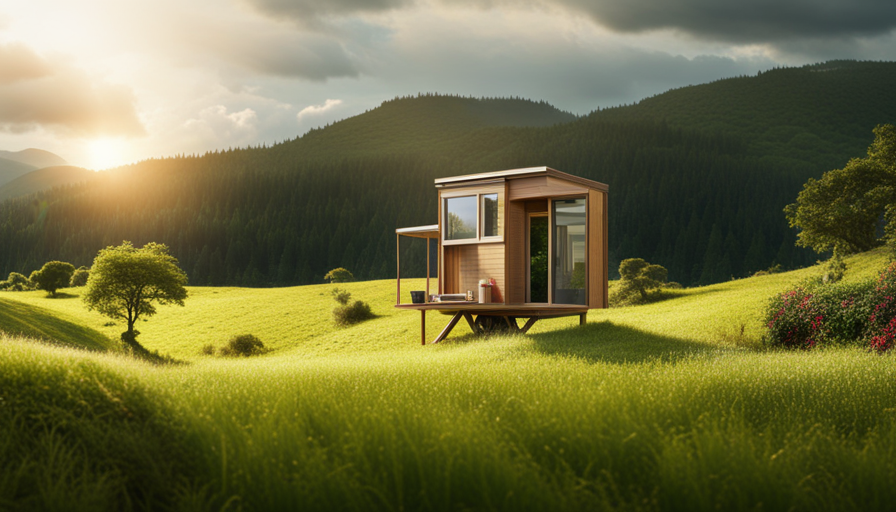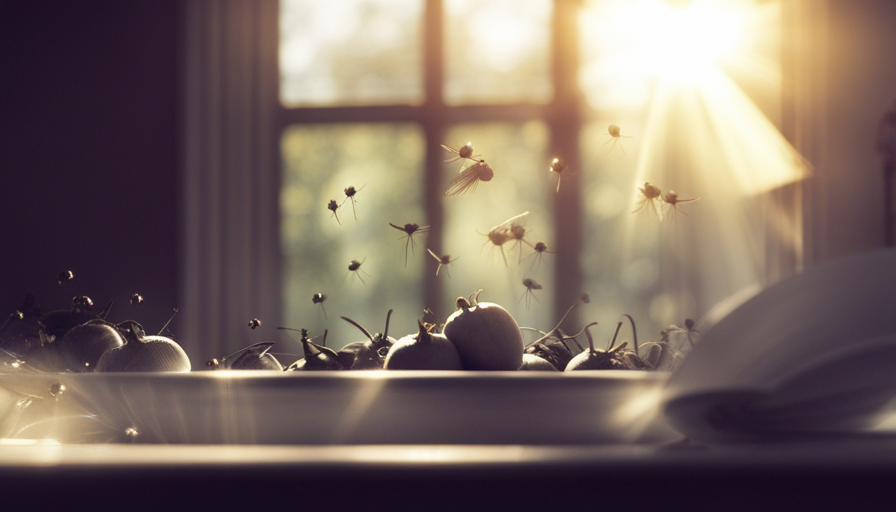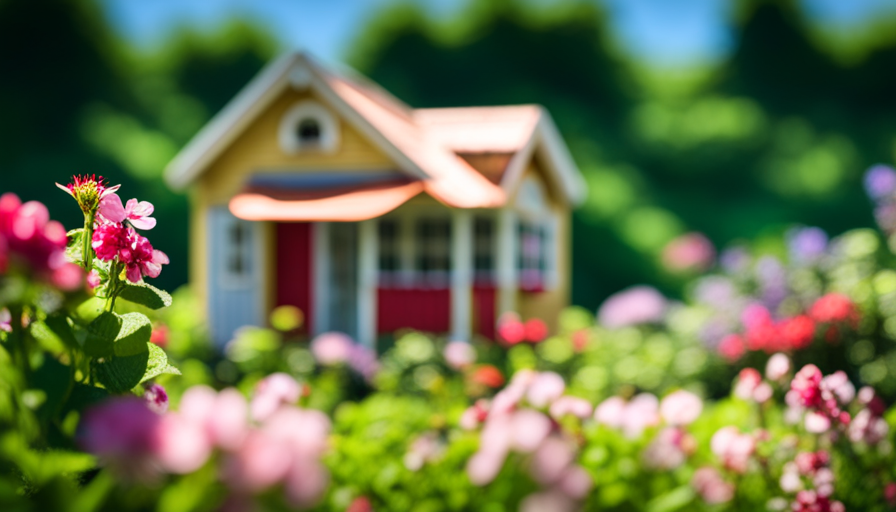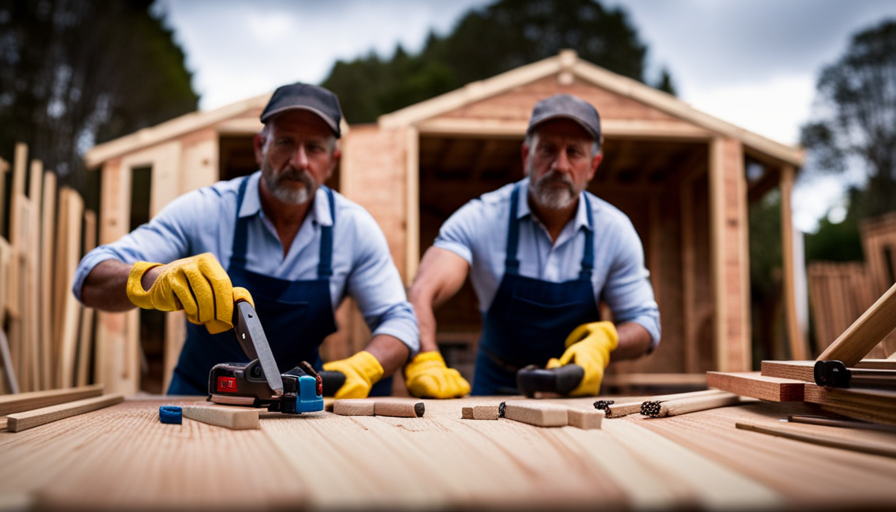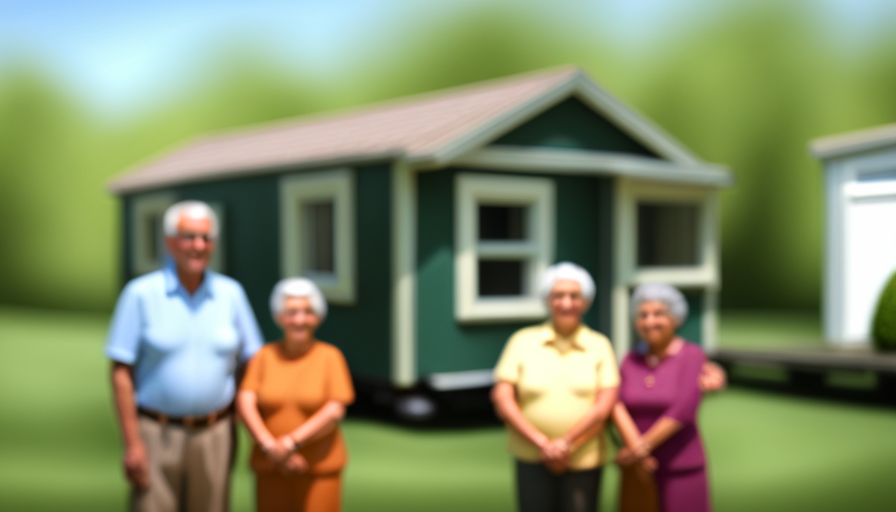Have you ever dreamed of escaping the burdensome weight of mortgage payments and living a simpler, more affordable life? Your answer might just be found in the irresistible charm of tiny house living! These small, yet cozy homes have become increasingly popular worldwide, offering a new and innovative approach to homeownership.
But before you embark on this exciting journey, it’s crucial to understand the true cost of a tiny house. In this article, we will delve into the nitty-gritty details and unveil the financial realities lurking beneath the charm of these petite abodes. Prepare to be astounded as we explore the construction expenses, financing options, ongoing maintenance, and even the potential resale value of these diminutive dwellings.
So, fasten your seatbelts and let’s dive headfirst into the world of tiny houses, where big dreams can come true at a fraction of the cost.
Key Takeaways
- The cost of building a tiny house includes construction expenses, hidden costs, and ongoing maintenance, but it is generally more affordable compared to traditional homeownership.
- Financing options for tiny houses include saving and budgeting, loans and mortgages, and grants and financial assistance programs.
- Zoning regulations vary by location and can impact the type and placement of tiny houses.
- Tiny houses have a smaller environmental footprint, consume less energy and water, and promote sustainability and reduced carbon footprint.
Types of Tiny Houses
If you’re looking to explore the types of tiny houses, you’ll find a wide range of options to suit your needs and preferences. Tiny houses come in various designs, each with its own unique features and layout.
From traditional cottages to modern sleek designs, there is something for everyone. Some popular types include the traditional gable roof, shed roof, and even tiny houses on wheels. The choice of design often depends on personal taste and the available space.
When considering a tiny house, it’s important to be aware of zoning regulations in your area. Zoning regulations vary from place to place and can impact the type of tiny house you can build or park. Some areas have specific zoning codes that restrict the size or placement of tiny houses. It’s crucial to research and understand these regulations before embarking on your tiny house journey.
Now that we’ve explored the types of tiny houses and zoning regulations, let’s move on to the next step: construction expenses.
Construction Expenses
During the building process, one might be surprised by the moolah required to construct a small dwelling. When it comes to constructing a tiny house, there are several factors that contribute to the overall construction expenses. The cost of building materials, labor, and permits are the primary components.
Building materials can vary in price depending on the quality and type of materials chosen. Additionally, labor costs can fluctuate depending on the region and the complexity of the project. It is crucial to carefully choose a builder who has experience in constructing tiny houses, as their expertise can help navigate potential pitfalls and minimize costs.
Hidden costs are also an important consideration when budgeting for a tiny house. These may include land preparation, utility connections, and inspections. Land preparation can entail clearing and leveling the site, which can add to the overall expenses. Utility connections, such as water and electricity, may require additional fees for installation. Inspections are another hidden cost that should not be overlooked, as they ensure compliance with building codes and regulations.
Constructing a tiny house involves careful consideration of various expenses. From selecting the right builder to accounting for hidden costs, it is essential to plan accordingly. Once the construction expenses are accounted for, the next step is to choose the right location for your tiny house.
Choosing the Right Location
When searching for the perfect spot to place your compact abode, envision a picturesque setting that complements the unique charm and character of your dream home.
One crucial factor to consider is the zoning regulations for tiny houses in your desired location. Different areas have different restrictions and requirements regarding the placement and size of tiny houses. It’s essential to research and understand these regulations to avoid any legal issues or setbacks during the construction process.
Additionally, the cost of utilities should be taken into account when choosing the right location for your tiny house. Depending on the area, utility costs can vary significantly. Some areas may have higher water, electricity, or gas rates, which can impact your monthly expenses. It’s crucial to consider these costs and factor them into your budget to ensure that you can comfortably afford the ongoing expenses associated with living in a tiny house.
Considering both the zoning regulations and utility costs will help you make an informed decision about the location of your tiny house. Once you have a clear understanding of these factors, you can move on to exploring financing options for your project.
Financing Options
When it comes to financing a tiny house, there are several key points to consider.
First, saving and budgeting are crucial in order to have enough funds to purchase or build a tiny house.
Second, loans and mortgages can be an option for those who need financial assistance, but it’s important to research and compare different lenders to find the best terms and interest rates.
Lastly, there are grants and financial assistance programs available for individuals who qualify, which can help make the dream of owning a tiny house more attainable.
Saving and Budgeting
To save and budget effectively, you can start by prioritizing your expenses and cutting back on non-essential items, because as the saying goes, ‘a penny saved is a penny earned.’
Here are four saving strategies and cost-cutting measures to help you reach your tiny house goals:
-
Track your spending: Use budgeting apps or spreadsheets to keep a close eye on where your money is going. This will help you identify areas where you can cut back.
-
Automate your savings: Set up automatic transfers from your checking to your savings account each month. This way, you won’t even have to think about saving, it will happen automatically.
-
Reduce utility costs: Implement energy-efficient measures in your current living situation to save money on utilities. This can include switching to LED lights, insulating your home, and using programmable thermostats.
-
Opt for DIY projects: Instead of hiring professionals, consider doing some of the work yourself. From simple repairs to building furniture, DIY projects can save you a significant amount of money.
By implementing these strategies, you can start saving towards your tiny house dream. Speaking of financing options, let’s now dive into loans and mortgages.
Loans and Mortgages
If you’re looking to achieve your dream of living in a small and affordable home, loans and mortgages can provide you with the financial help you need.
When it comes to financing a tiny house, there are several options available to consider. One option is refinancing your current mortgage to free up funds for your tiny house project. This can be done by either extending the term of your loan or obtaining a new loan with a lower interest rate.
Another option is applying for a specific tiny house loan, which is designed for individuals looking to purchase or build a tiny house. However, it’s important to note that these loans may have stricter credit score requirements compared to traditional mortgages. Therefore, it’s essential to have a good credit score to increase your chances of approval.
As we move forward to discuss grants and financial assistance, it’s important to explore all possible avenues to make your tiny house dream a reality.
Grants and Financial Assistance
Explore the realm of grants and financial aid, and let the winds of opportunity blow your tiny dream into a reality. When it comes to funding your tiny house, there are various grants and scholarships available specifically for alternative housing projects. These grants can help offset the cost of materials, labor, and land acquisition.
Additionally, crowdfunding campaigns have become a popular way to raise funds for tiny houses. Through online platforms, individuals can pitch their project to a wide audience and gather financial support. In fact, according to a study by Tiny Home Industry Association, 30% of tiny house owners were able to finance their homes through crowdfunding.
By utilizing grants and scholarships as well as crowdfunding campaigns, you can find the financial assistance needed to make your tiny house a reality.
Now, let’s discuss ongoing maintenance.
Ongoing Maintenance
Although ongoing maintenance is required, the cost of maintaining a tiny house is significantly lower compared to that of traditional homes. One of the primary reasons for this is the reduced maintenance costs associated with a smaller living space. With fewer rooms, less square footage, and simpler systems, there are fewer areas that require regular upkeep.
Additionally, the materials used in tiny houses are often chosen for their durability and low maintenance requirements, further reducing the need for costly repairs or replacements.
Another factor that contributes to the lower maintenance costs of tiny houses is the simplified maintenance schedule. With a smaller space to clean and maintain, the time and effort required for routine tasks such as cleaning, painting, and landscaping are significantly reduced. This not only saves money but also allows homeowners to spend more time enjoying their living space rather than maintaining it.
The ongoing maintenance of a tiny house is significantly more affordable compared to traditional homes. The reduced maintenance costs are a result of the smaller living space and simplified maintenance schedule. With lower expenses and less time spent on maintenance, tiny house owners can allocate their resources towards other aspects of homeownership, such as customization and personalization.
Customization and Personalization
Get ready to unleash your creativity and make your tiny living space truly your own! When it comes to tiny houses, customization options are endless, allowing you to create a personalized design that reflects your unique style and needs.
From the layout and materials to the color schemes and furnishings, every aspect of your tiny house can be tailored to suit your preferences. One of the key benefits of customizing a tiny house is maximizing the use of space. With careful planning and design, you can optimize every nook and cranny to ensure efficient storage and functionality. Whether it’s adding built-in shelves, hidden compartments, or multi-purpose furniture, customization allows you to make the most of your limited square footage.
Furthermore, customization also enables you to incorporate eco-friendly features and sustainable materials into your tiny house. From solar panels and rainwater harvesting systems to energy-efficient appliances and insulation, you can create a space that aligns with your green values.
As you delve into the realm of customization and personalized design, it’s important to strike a balance between aesthetics and functionality. Consider your lifestyle, habits, and future needs when making design choices. By carefully planning your customization options, you can create a tiny house that not only meets your immediate requirements but also adapts to your changing lifestyle in the long run.
Now, let’s explore the next section about long-term sustainability and how it plays a vital role in the overall cost of a tiny house.
Long-Term Sustainability
When considering the cost of a tiny house, customization and personalization are important factors to consider. However, it is equally crucial to think about the long-term sustainability and environmental impact of these homes. Tiny houses are often seen as a more sustainable housing option due to their smaller size and the use of eco-friendly materials.
To understand the long-term sustainability of tiny houses, it is essential to examine their environmental impact. By living in a smaller space, individuals consume fewer resources such as energy and water. Additionally, many tiny houses are designed with eco-friendly features like solar panels and composting toilets, further reducing their environmental footprint.
To illustrate the environmental benefits of tiny houses, let’s compare the average resource consumption of a traditional home to that of a tiny house.
| Resource | Traditional Home | Tiny House |
|---|---|---|
| Energy | High | Low |
| Water | High | Low |
| Waste | High | Low |
| Carbon Footprint | High | Low |
| Land Usage | High | Low |
As we can see from the table, tiny houses have a significantly lower environmental impact compared to traditional homes. This makes them a more sustainable housing option for those concerned about their ecological footprint.
Considering the long-term sustainability and environmental benefits, it is evident that tiny houses offer a promising solution for those seeking a greener lifestyle. However, community and social considerations also play a crucial role in the decision-making process.
Community and Social Considerations
Living in a close-knit community of like-minded individuals, sharing resources and supporting one another, can create a sense of belonging and foster a strong social network. Community engagement is a key aspect of tiny house living that goes beyond the physical structure itself.
Joining a tiny house community allows residents to connect with others who share similar values and lifestyles. This shared sense of purpose and camaraderie can lead to increased happiness and overall well-being.
In addition to the social benefits, tiny house communities also have a positive environmental impact. By clustering tiny houses together, the overall land and resource usage is minimized. This promotes sustainability and reduces the carbon footprint of each individual dwelling. Many tiny house communities also adopt eco-friendly practices such as rainwater harvesting, solar energy, and composting toilets. These initiatives further contribute to a greener lifestyle.
Transitioning to the next section about ‘resale value and investment potential’, it is important to consider the long-term implications of living in a tiny house community. While the initial investment in a tiny house may be lower than traditional homes, the resale value and investment potential can vary.
Resale Value and Investment Potential
When considering the resale value and investment potential of a tiny house, it’s important to analyze the market trends and demand. By examining current data and research, you can gain insight into the popularity and future growth of the tiny house market.
Factors such as location, size, and quality of construction can greatly influence the resale value of a tiny house.
Lastly, individuals who are considering renting out or selling their tiny house should carefully evaluate their options. They should consider factors such as rental demand, rental rates, and the potential for capital appreciation.
Market Trends and Demand
The rising demand for tiny houses is fueling market trends and driving down costs. This market growth is influenced by several key factors:
- Increasing interest in minimalist lifestyles and sustainable living options.
- Rising housing costs and the desire for affordable housing solutions.
- The ability to customize and personalize tiny houses according to individual needs.
- The flexibility and mobility that tiny houses offer, allowing homeowners to live in different locations.
According to recent research, the average cost of a tiny house has decreased by 23% in the past five years due to these market trends. This makes tiny houses even more affordable and accessible to a wider range of individuals. These factors affecting the market demand and cost of tiny houses will also have an impact on their resale value.
Factors Affecting Resale Value
Factors such as customization, mobility, and sustainability can greatly influence the resale value of tiny homes. Market factors play a significant role in determining how much a tiny house is worth when it comes time to sell. Demand for tiny homes, overall housing market conditions, and location can all impact resale value. Additionally, design choices can also affect the value of a tiny house.
Unique and innovative designs that maximize space and functionality tend to be more appealing to buyers, thus increasing resale value. On the other hand, outdated or poorly executed designs may decrease the value. As the market for tiny homes continues to evolve, it’s important to stay informed about current design trends and market demands to ensure the highest possible resale value.
Understanding these factors can help when deciding whether to rent out or sell your tiny house.
Renting Out or Selling Your Tiny House
Now that we’ve discussed the factors that can affect the resale value of a tiny house, let’s explore the option of renting out or selling it. This decision can have significant financial implications and should be carefully considered.
One aspect to consider is the rental income potential of your tiny house. Depending on the location and demand for tiny house rentals in your area, you could potentially earn a steady stream of income. However, it’s important to also consider the tax implications of renting out your tiny house, as rental income is generally subject to taxes. Understanding the tax laws and regulations surrounding rental properties is crucial to ensure compliance and maximize your financial benefits.
With this in mind, let’s now delve into the pros and cons of tiny house living.
Pros and Cons of Tiny House Living
When considering the pros and cons of tiny house living, it’s important to examine the benefits of a minimalist lifestyle. Research shows that living in a tiny house can lead to a reduction in material possessions and an increase in overall life satisfaction.
However, it’s also crucial to recognize the challenges and limitations that come with living in a small space, such as limited storage and privacy.
Before making the decision to live in a tiny house, it’s essential to carefully evaluate whether this lifestyle is the right fit for you, taking into account your personal preferences and needs.
Benefits of a Minimalist Lifestyle
Living a minimalist lifestyle has its perks, like experiencing the freedom of owning less stuff and feeling unburdened by material possessions. A minimalist design promotes simplicity and functionality, allowing individuals to focus on what truly matters in life.
Research shows that decluttering benefits not only physical space but also mental well-being. By reducing the number of belongings, one can create a calming environment that promotes relaxation and reduces stress.
Additionally, embracing minimalism has been linked to increased productivity and improved decision-making skills. It encourages individuals to prioritize their goals and eliminate distractions, leading to a more focused and efficient lifestyle.
Transitioning into the subsequent section about challenges and limitations, it is important to acknowledge that adopting a minimalist lifestyle may require significant changes and adjustments.
Challenges and Limitations
One of the biggest challenges of embracing minimalism is the need to let go of sentimental items. It can be difficult to part with possessions that hold emotional value, but downsizing and decluttering is a necessary step in transitioning to a tiny house lifestyle. However, challenges in zoning, building codes, and regulations can also pose significant obstacles for those interested in building a tiny house. These restrictions vary by location and can limit where a tiny house can be placed or how it can be constructed. Additionally, the downsizing process itself can be overwhelming, as individuals must carefully consider what items they truly need and what can be let go. Despite these challenges, the benefits of a minimalist lifestyle and the freedom that comes with living in a tiny house make it a worthwhile endeavor. Is a tiny house right for you?
Is a Tiny House Right for You?
Now that we’ve explored the challenges and limitations of tiny houses, let’s delve into whether a tiny house is the right choice for you.
Making the decision to downsize and live in a tiny house is a personal one, as it involves a significant lifestyle change. However, before you make the leap, it’s essential to consider the financial aspect. One of the key factors that often comes into play when deciding between a tiny house and a traditional home is the cost.
While tiny houses are generally more affordable upfront, there are other financial considerations to take into account, such as maintenance, utilities, and land costs. To help you weigh the options, let’s compare the overall cost of owning and maintaining a tiny house versus a traditional home.
Consider the following nested bullet point list:
-
Advantages of a Tiny House:
- Lower upfront cost
- Reduced monthly expenses
-
Advantages of a Traditional Home:
- Potential for higher property value appreciation
- More space for a growing family
By considering these factors, you can determine whether a tiny house aligns with your financial goals and lifestyle preferences.
Frequently Asked Questions
What are the zoning and legal considerations for living in a tiny house?
Zoning regulations and legal requirements must be considered when living in a tiny house. These rules dictate where and how you can place your home, ensuring compliance with local laws and ordinances.
How can I ensure the safety and security of a tiny house?
To ensure the safety and security of a tiny house, I recommend implementing safety measures like smoke detectors, fire extinguishers, and carbon monoxide detectors. Additionally, installing security systems such as motion sensor lights and surveillance cameras can provide added protection.
Are tiny houses suitable for families with children?
Tiny houses can be suitable for families with children, but affordability and space limitations should be considered. Research shows that some families have successfully adapted to tiny house living by maximizing space and implementing creative storage solutions.
What are the potential challenges of living off-grid in a tiny house?
Living off-grid in a tiny house presents numerous challenges. From limited access to utilities and resources to the need for alternative energy sources and water management, it requires careful planning and adaptation to ensure a sustainable lifestyle.
Can I build a tiny house on my own or do I need professional help?
Building a tiny house on your own is possible, but it’s important to consider building regulations and obtain necessary permits. Professional help may be beneficial to ensure compliance and avoid costly mistakes. Cost estimation varies depending on factors like materials and design choices.
Conclusion
In conclusion, after analyzing the various factors involved in the cost of a tiny house, it’s clear that the decision to embrace this lifestyle requires careful consideration. The construction expenses, financing options, ongoing maintenance, and long-term sustainability all play a significant role in determining the overall cost.
However, the potential for a sense of community, reduced environmental impact, and the possibility of a solid resale value can be enticing. Ultimately, the choice to live in a tiny house is a personal one that should be based on individual preferences and priorities.
Hi, I’m Emma. I’m the Editor in Chief of Tiny House 43, a blog all about tiny houses. While tree houses are often associated with childhood, they can be the perfect adult retreat. They offer a cozy space to relax and unwind, surrounded by nature. And since they’re typically built on stilts or raised platforms, they offer stunning views that traditional homes simply can’t match. If you’re looking for a unique and romantic getaway, a tree house tiny house might just be the perfect option.
